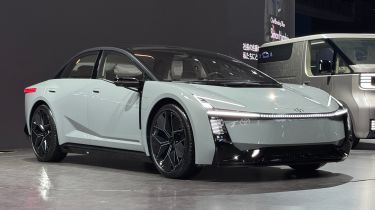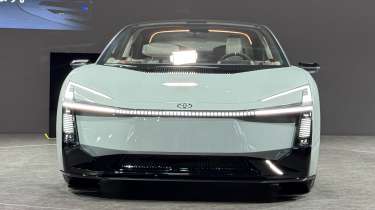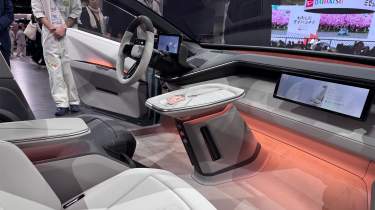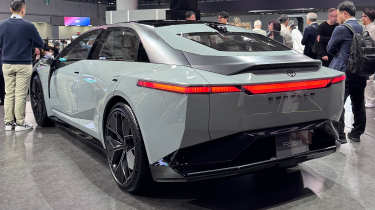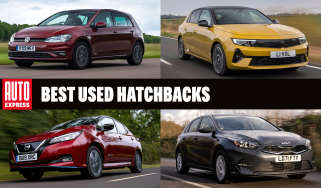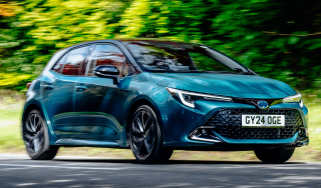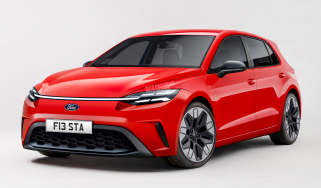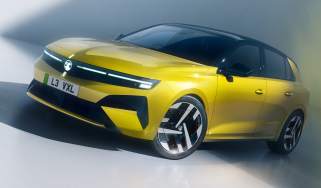New Toyota Corolla Concept: the latest details on the world’s most popular car
Toyota will challenge anyone to call the Corolla boring if it looks anything like this striking concept
New details about Toyota’s new Corolla concept have been revealed, confirming the company’s intention to make this just about the most adaptable single model on sale. Introduced at this year’s Japanese Mobility Show, the eyecatching concept might look like pure fiction, but it’s closer than you may think to being the Corolla that’ll go on sale in 2027.
The show car has been presented in a saloon bodystyle that reveals lots of new design directions the production car will take when it’s revealed in the coming years. These range from a new take on the three-box shape, to the digital interfaces – everything on the concept is relevant – and now we’re getting the first indications of the car’s powertrains.
What’s under the bonnet?
The answer to the question of what will power Toyota’s new global car is a simple one: just about anything. The company will offer the Corolla with pure ICE, hybrid, plug-in hybrid and all-electric powertrains.
There won’t be any compromises in passenger or luggage space, either, because the floor will be variable enough to fit batteries underneath, and an internal-combustion engine will fit under the bonnet. This is to give Toyota maximum flexibility with the car, wherever it’s sold around the world, whether that be EV-hungry Europe, or more conservative ICE-friendly places like the US.
One engine option that has been detailed so far is a brand-new and highly efficient 1.5-litre four-cylinder hybrid. As with the rest of the car, the aim is flexibility, so it’ll come initially as a series hybrid layout with a planetary gear set-up – much like the current set-up – right through to being used as an occasional back-up engine for a plug-in hybrid.
It can also be turbocharged for more performance, but for a full high-performance application, there’s also Toyota’s new 400bhp 2.0-litre turbocharged four – which can also be paired with a hybrid system. Could this spawn a next-gen GR Corolla? We wouldn’t bet against it.
Why does the Corolla Concept look like that?
The new direction starts with the car’s overall shape, which features a much lower base point for the windscreen that’s not unlike that of the latest Toyota Prius. This extended windscreen has many benefits, such as aero efficiency and an enhanced feeling of interior space, but the effect is taken further with front door windows that also dip down to give the cabin a particularly airy feel.
As well as being deeper than normal, the front screen also extends further back into the roof, nearly reaching the B-pillar before meeting a solid roof panel at the rear. We asked Toyota Europe’s design chief Lance Scott whether all these design elements are just a fantasy or something we might actually see, and he replied: “We’re trying something new, we’re challenging the direction we go in with Corolla.”
The concept’s rear end is just as progressive, with a tapering upper body that incorporates a small rear window framed in body colour that visually ‘floats’ above a black section that also incorporates a small ducktail spoiler. This is angled to a point of nearly turning the car into a fastback, but the flat shoulders above the rear wheels retain the look and feel of a saloon.
The lighting at both ends features three-dimensional LED elements, but for once it’s not the lightbars that make the biggest visual statement. Instead, it’s the Corolla’s eccentric shape and low windscreen.
However, the concept’s saloon bodystyle won’t be the only one available in the Corolla family, with hatchback and estate versions due to be reimagined in this new context.
If you’re in the market for a new Toyota Corolla, make sure to check out our Buy a Car service, where prices start at less than £28,000.
What’s going on inside?
Like the exterior, the cabin also represents a new era of Toyota design. Emphasising the low-set windscreen is a radical look that will influence all future Toyota interiors in passenger cars like the Corolla. Rather than the driver and passenger sharing one display, Toyota has created a set-up that gives each their own interface, on the grounds that the requirements of these systems are different whether you’re in the driver’s or passenger’s seat.
In front of the driver is a new column-mounted screen, which acts as a traditional driver’s display. Here, not only driving data and speed can be shown, but potentially navigation and other road information, too. On either side of this main screen are two further interfaces that control elements like the media, air-conditioning and other core driving functions.
The passenger’s screen has a larger display designed to project media or access elements like the navigation. If there’s no passenger in the seat, the screen will seamlessly disappear into the dash, creating a cleaner and less distracting environment for the driver.
Scott said: “Could we, at least from a design point of view change [the interior experience]? How are we going to give a focused environment for the driver, but also a contrast to a relaxed, open one for the passenger? We can go beyond just displays, and do things like change the seats, give drivers and passengers a different experience. We’re really pushing for it.”
Between the front seats sits a sort of pedestal, which houses the start button and a drive selector. While this sort of minimalism is nice to look at, we can imagine this being more of a multi-use platform in a production car, with cup-holders, a wireless phone charger and storage for other small items.
What’s under the bonnet?
With such a widespread audience and the scale to back it up, Toyota’s next Corolla will be available in ICE, PHEV and EV forms, with no difference in the car’s proportions, practicality or driving dynamics. This tells us that the future production model will be based on a flexible platform that’s capable of housing batteries under the floor for an EV variant, and fitting a small ICE powertrain – likely hybrid – under the bonnet.
While this does sound like a compromise, it’s one that other manufacturers have had success with, and helps keep the model in line with global demand, even if that shifts within the model’s life-cycle.
Will Toyota be able to build something like this?
It might be easy to brush off this car’s more eccentric elements as concept car bling, but this is very much a dry run for the next-generation model to receive feedback from both media and customers before it goes into production.
An added bonus of having such potentially high sales figures for the new Corolla is that Toyota can invest in new engineering solutions to meet the demands of its customers, giving me plenty of faith that the car we’ll actually see might just look half as cool as this new concept.
“This is what the design team wants to express,” said Scott. “Nowadays, the engineers are very open to really challenging themselves, and achieving what the designers are looking for.”
Get the latest and best car news and reviews, first! Follow Auto Express on Google today.
Find a car with the experts

